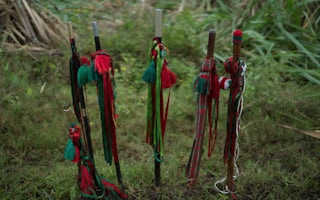Tropical forests have been in the headlines a lot recently, for all the wrong reasons - wildfires, illegal deforestation, difficult politics, and the list goes on.
However, there are also reasons for hope. One such bright spot is the efforts gaining traction in the Pastaza region of Ecuador.
Why tropical forests? Because, at the moment, tropical deforestation puts only slightly less carbon pollution into the atmosphere than does the United States.
By one estimate, if we protect them, tropical forests could contribute more than 20 per cent of the emissions reductions climate needed to achieve the goals of the Paris Agreement.
Despite the urgency, it behooves us to pause and consider not just why to protect tropical forests, but how to do so most effectively.
The answer? Let Indigenous peoples lead the effort. That’s the key.
Indigenous peoples have lived on their lands, including those in tropical forests, since time immemorial and they know how to take care of them.
When RAISG, a consortium of non-governmental organisations, mapped and analysed deforestation trends in the Amazon rainforest, they found that indigenous territories there had lower deforestation rates even than protected areas. Indigenous peoples truly are nature’s greatest guardians.
This is easy to say but much harder to put into practice.
There are entrenched political and economic interests that are indifferent or even hostile to meaningful, rights-based participation by indigenous peoples because that would disrupt lucrative activities on indigenous lands (that indigenous peoples often don’t benefit from).
Even when intentions are good, it’s a challenge to foster participatory decision-making that centers Indigenous needs, wants, and worldviews. It can be done though. Pastaza, a province in the Ecuadorian Amazon, shows how.
More than a decade ago, the Pastaza provincial government began incorporating conservation principles into the province’s zoning and development plan.
Concurrently, several of Pastaza’s indigenous nationalities began, with Nature and Culture International’s support, enrolling portions of their lands into Ecuador’s SocioBosque program, which pays communities for conserving their communal forests.
These early achievements set the stage for the creation, in 2017, of a 6.2-million-acre provincial protected area.
Subsequently, the partners in this effort - the provincial government, Pastaza’s seven indigenous nationalities, the Confederation of Indigenous Nationalities of the Ecuadorian Amazon (CONFENIAE), and several conservation NGOs - developed and are now implementing a REDD+ plan to reduce deforestation and create a conservation-based economy in the protected area.
Reducing Emissions from Deforestation and Forest Degradation (REDD+ for short) is a United Nations framework intended to guide and fund developing countries in reducing greenhouse gas emissions from tropical deforestation.
There’s a lively ongoing debate as to REDD+’s pros and cons. Some criticisms about REDD+ are ideological: nature shouldn’t be commodified. Some are practical: REDD+ payments are linked to reducing deforestation rates so areas with historically low deforestation have limited ability to secure REDD+ credits.
In other words, REDD+ rewards improvement, not being good in the first place.
One of the most salient criticisms is that, by and large, REDD+ benefits haven’t reached the indigenous peoples who do the most to save tropical forests.
Although REDD+ has shortcomings, we should improve, not abandon it. And there are exciting advances creating REDD+ models that include indigenous peoples in decision-making and ensure that indigenous communities see real benefits. That’s what happening in Pastaza.
As a member of the Governors’ Climate and Forests (GCF) Task Force, the Pastaza Provincial Government has formally endorsed GCF’s Guiding Principles for Collaboration between Subnational Governments, Indigenous Peoples and Local Communities, as has CONFENIAE.
These 13 principles, based on indigenous rights recognition and security, participation, and benefits sharing, lay out a collaborative framework between sub-national governments and indigenous peoples to protect forests and mitigate climate change.
To operationalize these principles in Pastaza, an inclusive governance structure has been created to oversee and manage the provincial protected area and the REDD+ plan being implemented within.
The governing consortium includes a Consultative Council comprising representatives of the seven indigenous nationalities in Pastaza, each of whom have a vote, as well as a technical working group comprising 10 conservation non-profits.
Formal structures are important, but successful partnerships are based on trust. That’s why the early activities in Pastaza were important.
We phased the milestones in Pastaza sequentially and achieved them gradually. This was deliberate, to build trust.
In our world of fleeting attention spans and instant gratification, this kind of patience is hard to muster and rarely aligns with short funding and political cycles. But it’s necessary if we are to achieve the lasting results we want.
Matthew Clark is president and CEO of Nature and Culture International.
This story was published with permission from Thomson Reuters Foundation, the charitable arm of Thomson Reuters, that covers humanitarian news, climate change, resilience, women’s rights, trafficking and property rights. Visit http://news.trust.org/climate.











